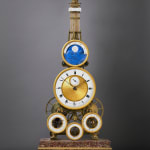Verneuil
Provenance
Christie's London, 12th June 1996, lot 273. Léon Hatot.
Literature
Derek Roberts, "Continental and American Skeleton Clocks", 1989, p. 48, pl. 35, illustrating a very similar clock signed Le Roy à Paris. And pp. 52-53, pls. 37 and 38, illustrating two astronomical skeleton clocks with gridiron pendulums and three or five subsidiary calendar dials below both signed Verneuil as well as Nicol à Paris.
An extremely fine Empire gilt bronze, brass and Spanish brocatelle marble astronomical skeleton clock of one month duration, signed on the white enamel chapter ring Verneuil h.er M.ien, the chapter ring with a spiral beaded gilt bronze bezel, Roman numerals for the hours and minutes and a pair of blued steel Breguet hands, with a gilt guilloché centre set with a subsidiary enamel seconds dial with blued steel pointer, with a conforming bezel to the blue enamel lunar dial above with moons finely decorated en grisaille below a calibrated ring for the appropriate age, with three subsidiary calendar rings below the main chapter ring for the days of the week and their corresponding symbols, the days of the month and the months of the year with the relevant signs of the zodiac, each with blued steel hands. The spring barrel movement with pierced out Y-shaped plates and large great wheels, the going train with pinwheel escapement regulated by a clearly visible gridiron pendulum positioned above the clock, with adjustable crutchpiece and fronted by a thermometer with a white enamel scale inscribed Elementa Suis Propriis Armis Victa, the count wheel strike on a bell positioned on the backplate, the whole resting on a stepped rectangular brocatelle marble base with a gilt bronze gallery mount matching the bezels on brass bun feet, the movement frame on brass blocks with milled levelling knobs, on its original velvet-covered plinth and with original glass dome
Paris, date circa 1810
Height 72.5 cm, excluding the plinth and dome.
Verneuil appears to have specialised in creating exceptional skeleton clocks of the highest mechanical and aesthetic quality. However surprisingly little is known of this Parisian maker; Tardy records a father and son of the same name, the elder based at 42 rue St Honoré and a younger, who sometimes signed his work Verneuil Jeune, who was based at rue du Contrat Social in 1806 and at Faubourg St-Martin in 1815. It is unclear exactly which was responsible for the present piece although it is more likely to be by the former. All works bearing Verneuil's name share a close stylistic resemblance. Of varying complexity, the majority include calendar work laid out in a similar manner. Some have silvered dials while others, such as the present example, have white enamel dials and the majority rest on marble plinths. One particular example with a very elaborate lunar dial is further adorned with sumptuous gilt bronze mounts including Egyptian female figures, lion supports and mythological scenes on the marble base (illustrated ibid. p. 56, pl. 41).
Verneuil's name sometimes appears, as here, on the dial but more often up the side of the front plate but interestingly a number of them also bear the name of Nicol à Paris (sometimes on the backplate but also on at least on one occasion on the dial). Nicol, who is not recorded in Tardy, may have been a supplier of blanc-roulants (the basic unfinished movement) to Verneuil or possibly it was the other way round, alternatively the two may have worked in partnership. Since the shapes of the plates of a certain group of clocks all bear a close resemblance to those used by Berthoud it may be that Verneuil or Nicol were supplying blanc-roulants to other makers. The present clock is of particular interest in that the arrangement of the dials and overall concept is very similar to another signed Le Roy à Paris (as noted in Roberts, op.cit). The Latin inscription on the thermometer Elementa Suis Propriis Armis Victa, (which can loosely be translated as 'The elements are defeated by their own weapon') also appears on a regulator by the royal clockmaker Robert Robin.



